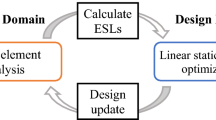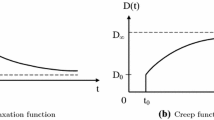Abstract
In the real world, structural systems may not have linear static characteristics. However, structural optimization has been developed based on static responses because sensitivity analysis regarding static finite element analysis is developed quite well. Analyses other than static analysis are heavily required in the engineering community these days. Techniques for such analyses have been extensively developed and many software systems using the finite element method are easily available in the market. On the other hand, development of structural optimization using such analyses is fairly slow due to many obstacles. One obstacle is that it is very difficult and expensive to consider the nonlinearities or dynamic effects in the way of conventional optimization. Recently, the equivalent static loads method for non linear static response structural optimization (ESLSO) has been proposed for structural optimization with various responses: linear dynamic response, nonlinear static response, and nonlinear dynamic response. In ESLSO, finite element analysis other than static analysis is performed, equivalent static loads (ESLs) are generated, linear static response structural optimization is carried out with the ESLs and the process iterates. A software system for the automatic use of ESLSO is developed and described. One of the advantages of ESLSO is that it can use well developed commercial software systems for structural analysis and linear static response structural optimization. Various analysis and optimization systems are integrated in the developed system. The structure of the system is systematically defined and the software is developed by the C++ language on the Windows operating system.



















Similar content being viewed by others
References
Abaqus Analysis User’s Manual Version 6.8 (2008) SIMULIA, Providence, RI
Abbasi M, Kazemi R, Nazari AG (2011) Using a parametric method for investigating automotive crashworthiness. Int J Automot Eng 1(3):165–172
Altair OptiStruct, Introduction to OptiStruct FEA Version 10.0 (2009) Altair Engineering, Inc., MI, U.S.A.
Bathe KJ (1996) Finite element nonlinear analysis in solid and structural mechanics. Finite Element Procedures in Engineering Analysis. Prentice Hall, Englewood Cliffs
Bendsøe MP (1989) Optimal shape design as a material distribution problem. Struct Optim 1(4):193–202
Bendsøe MP, Sigmund O (2003) Topology optimization by distribution of isotropic material. Topology optimization: theory, methods and applications. Springer, Germany
Choi JS (2014) Multidisciplinary design optimization of the flapping wing system for forward flight. Hanyang University, Seoul (In Korean)
Choi WS, Park GJ (2002) Structural optimization using equivalent static loads at all the time intervals. Comput Method Appl Mech Eng 191(19–20):2105–2122
Choi JS, Zhao L, Park GJ, Agrawal SK, Kolonay RM (2011) Enhancement of a flapping wing using path and dynamic topology optimization. AIAA J 49(12):2616–2626
Christensen J, Bastien C, Blundell MV (2013) The feasibility of ESLM for BIW roof structure development and optimization. J Math Res Appl 1(2):34–47
Cook R, Malkus D, Plesha M, Witt R (2001) Concepts and applications of finite element analysis. John Wiley & Sons. Inc., New York
Duddeck F (2011) New approaches for shape and topology optimization for crashworthiness. 2011 NAFEMS world Congress. Boston, USA
GENESIS 10.0 User’s Manual (2009) Vanderplaats Research and Development, Inc
Green NS, Canfield RA, Swenson ED, Yu W, Blair M (2009) Structural optimization of joined-wing beam model with bend-twist coupling using equivalent static loads. 50th AIAA/ASME/ASCE/AHS Structures, Structural Dynamics and Materials Conference, California, USA
Haftka RT, Gürdal Z (1992) Elements of structural optimization. Kluwer, Dordrecht
Hong EP, You BJ, Kim CH, Park GJ (2010) Optimization of flexible components of multibody systems equivalent static loads. Struct Multidiscip Optim 40(1–6):549–562
Jang HH, Lee HA, Lee JY, Park GJ (2012) Dynamic response topology optimization in the time domain using equivalent static loads. AIAA J 50(1):226–234
Jeong SB, Yi SI, Kan CD, Nagabhushana V, Park GJ (2008) Structural optimization of an automobile roof structure using equivalent static loads. Proc Inst Mech Eng D J Automob Eng 222(11):1985–1995
Jeong SB, Yoon S, Xu S, Park GJ (2010) Non-linear dynamic response structural optimization of an automobile frontal structure using equivalent static loads. Proc Inst Mech Eng D J Automob Eng 224(4):489–501
Kang BS, Park GJ, Arora JS (2005) Optimization of flexible multibody dynamic systems using the equivalent static load method. AIAA J 43(4):846–852
Kim YI, Park GJ (2009) Nonlinear dynamic response structural optimization using equivalent static loads. Comput Methods Appl Mech Eng 199(9–12):660–676
Kurtaran H, Eskandarian A, Marzougui D, Bedewi NE (2002) Crashworthiness design optimization using successive response surface approximations. Comput Mech 29:409–421
Lee KK, Lee KH, Han SH (2011) Use of an orthogonal array based on the kriging model to maximize the fatigue life of a turbine blade. Int J Struct Integr 2(3):303–312
Lee HA, Park GJ (2012) Topology optimization for structures with nonlinear behavior using the equivalent static loads. ASME-J Mech Des 134(3):031004–031014
Lee JJ, Park GJ (2014) Optimization of the structural and process parameters in the sheet metal forming process. J Mech Sci Technol 28(2):605–619
Lee JJ, Jung UJ, Park GJ (2013a) Shape optimization of the workpiece in the forging process using equivalent static loads. Finite Elem Anal Des 69:1–18
Lee SJ, Lee HA, Yi SI, Kim DS, Yang HW, Park GJ (2013b) Design flow for the crash box in a vehicle to maximize energy absorption. Proc Inst Mech Eng D J Automob Eng 227(2):179–200
Li M, Tang W, Yuan M (2014) Structural dynamic topology optimization based on dynamic reliability using equivalent static loads. Struct Multidiscip Optim 49(1):121–129
LS-DYNA User’s Manual (2006) Livermore Software Technology Co., Livermore, CA
MD NASTRAN R3 User’s Manual (2008) MSC Software Co., Santa Ana, CA, U.S.A.
Microsoft Press (1998) MFC Library Reference, Redmond, WA, USA
Müllershön H, Erhart A, Schmacher P (2013) Topology and topometry optimization of crash applications with the equivalent static load method. 10th World Congress on Structural and Multidisciplinary Optimization. Orland, Florida, USA
Müllershön H, Erhart A, Anakiev K, Schmacher P, Kassegger H (2013) Application of the equivalent static load method for impact problems with GENESIS and LS-DYNA. Automotive CAE Grand Challenge. Hanau
Park GJ (2007) Analytic methods for design practice. Springer, Germany
Park GJ (2011) Technical overview of the equivalent static loads method for non-linear static response structural optimization. Struct Multidiscip Optim 43(3):319–337
Park GJ, Kang BS (2003) Validation of a structural optimization algorithm transforming dynamic loads into equivalent static loads. J Optim Theory Appl 118(1):191–200
Reddy JN (2004) Material nonlinearities and coupled problems. An introduction to nonlinear finite element analysis. Oxford University Press, New York
Sherif K, Irschik H (2010) Efficient topology optimization of large dynamic finite element systems using fatigue. AIAA J 48(7):1339–1347
Shin MK, Park KJ, Park GJ (2007) Optimization of structures with nonlinear behavior using equivalent loads. Comput Methods Appl Mech Eng 196(4–6):1154–1167
Stander N, Roux W, Pattabiraman S, Dhulipudi R (1999) Response surface approximations for design optimization problems in nonlinear dynamics. ASME, Emerging Technologies in Fluids, Structure and Fluid/Structure Interactions, PVP-Vol. 396
Stolpe M (2014) On the equivalent static loads approach for dynamic response structural optimization. Struct Multidiscip Optim. doi:10.1007/s00158-014-1101-3
Stroustrup B (2000) The C++ Programming Language. Addison Wesley, Reading
Tromme E, Brüls O, Virlez G, Duysink P (2013) Structural optimization of flexible components under dynamic loading within a, multibody system approach a comparative evaluation of optimization methods based on a 2-dof robot application. 10th World Congress on Structural and Multidisciplinary Optimization, Orlando, Florida, USA
Vanderplaats GN (1993) Thirty years of modern structural optimization. Adv Eng Softw 16(2):81–88
Yi SI, Lee HA, Park GJ (2011) Optimization of a structure with contact conditions using equivalent loads. J Mech Sci Technol 25(3):773–782
Yi SI, Lee JY, Park GJ (2012) Crashworthiness design optimization using equivalent static loads. Proc Inst Mech Eng D J Automob Eng 226(1):23–38
Acknowledgments
This work was supported by the research fund of Hanyang University (HY-2013-P). The authors thank Mrs. MiSun Park for her English correction of the manuscript.
Author information
Authors and Affiliations
Corresponding author
Rights and permissions
About this article
Cite this article
Lee, HA., Park, GJ. A software development framework for structural optimization considering non linear static responses. Struct Multidisc Optim 52, 197–216 (2015). https://doi.org/10.1007/s00158-015-1228-x
Received:
Revised:
Accepted:
Published:
Issue Date:
DOI: https://doi.org/10.1007/s00158-015-1228-x




